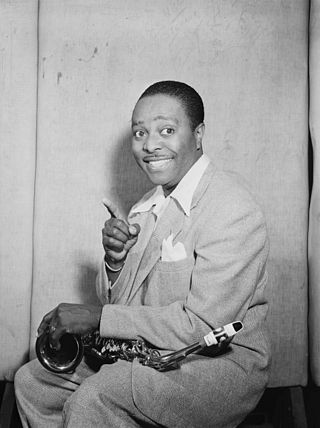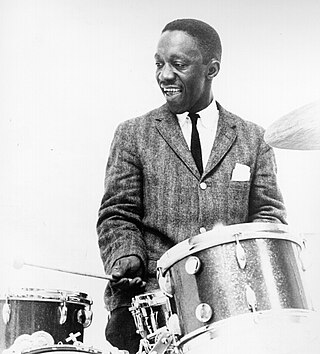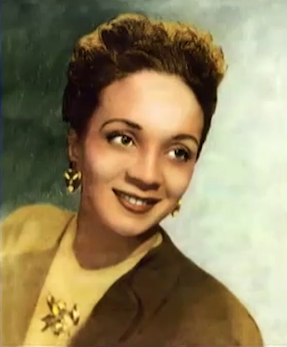Related Research Articles

Louis Thomas Jordan was an American saxophonist, multi-instrumentalist, songwriter and bandleader who was popular from the late 1930s to the early 1950s. Known as "the King of the Jukebox", he earned his highest profile towards the end of the swing era. He was inducted into the Rock and Roll Hall of Fame as an "early influence" in 1987.

Hoagland Howard Carmichael was an American musician, composer, songwriter, actor and lawyer. Carmichael was one of the most successful Tin Pan Alley songwriters of the 1930s, and was among the first singer-songwriters in the age of mass media to utilize new communication technologies such as television, microphones, and sound recordings.

Johnny Otis was a first generation Greek-American singer, musician, composer, bandleader, record producer, and talent scout. He was a seminal influence on American R&B and rock and roll. He discovered numerous artists early in their careers who went on to become highly successful in their own right, including Little Esther Phillips, Etta James, Alan O'Day, Big Mama Thornton, Johnny Ace, Jackie Wilson, Little Willie John, Hank Ballard, and The Robins, among many others. Otis has been called the "Godfather of Rhythm and Blues".

Arthur Blakey was an American jazz drummer and bandleader. He was also known as Abdullah Ibn Buhaina after he converted to Islam for a short time in the late 1940s.

Claude Thornhill was an American pianist, arranger, composer, and bandleader. He composed the jazz and pop standards "Snowfall" and "I Wish I Had You".

David Nathaniel Baker Jr. was an American jazz composer, conductor, and musician from Indianapolis, as well as a professor of jazz studies at the Indiana University Jacobs School of Music. Baker is best known as an educator and founder of the jazz studies program. From 1991 to 2012, he was conductor and musical and artistic director for the Smithsonian Jazz Masterworks Orchestra. He has more than 65 recordings, 70 books, and 400 articles to his credit.

Erroll Louis Garner was an American jazz pianist and composer known for his swing playing and ballads. His instrumental ballad "Misty", his best-known composition, has become a jazz standard. It was first recorded in 1956 with Mitch Miller and his orchestra, and played a prominent part in the 1971 motion picture Play Misty for Me.
Larry Ridley is an American jazz bassist and music educator.

Leroy Carr was an American blues singer, songwriter and pianist who developed a laid-back, crooning technique and whose popularity and style influenced such artists as Nat King Cole and Ray Charles. Music historian Elijah Wald has called him "the most influential male blues singer and songwriter of the first half of the 20th century". He first became famous for "How Long, How Long Blues", his debut recording released by Vocalion Records in 1928.

Indiana Avenue is a historic area in downtown and is one of seven designated cultural districts in Indianapolis, Indiana. Indiana Avenue was, during its glory days, an African American cultural center of the area. The Indiana Avenue Historic District within the area was designated a United States national historic district in 1987.
Virtue Hampton Whitted was an American jazz singer and bassist who is best known for her performances during the 1940s and 1950s as a member of the Hampton family band and The Hampton Sisters, a musical group she formed during World War II with her siblings, Aletra, Carmalita, and Dawn Hampton.

Owl Studios is a jazz record label founded in Indianapolis, Indiana, in 2005. In 2013 the label was sold and renamed Owl Music Group.
Buselli–Wallarab Jazz Orchestra is a jazz orchestra consisting of seventeen pieces.
Otis Ray Appleton was an American jazz drummer.

Ann Baker was an American jazz singer. Baker was discovered by Louie Armstrong and played with his band on Broadway. She is best known for her time spent as a member of Billy Eckstine's band, "The Dream Band" where she performed with Charlie Parker, Dizzy Gillespie, Dexter Gordon, Miles Davis and Art Blakey.
Emmett I. Brown Jr. was a professional photographer who is most noted for documenting Indianapolis, Indiana's jazz music scene along Indiana Avenue, a hub of activity for the city's African-American community in the 1940s and 1950s. Brown opened his own photography studio, the Brown Show Case, on Indiana Avenue in the late 1940s. During a brief residence in Chattanooga, Tennessee, in the mid-1950s, Brown opened a photography studio and became an editor at Sepia magazine. Brown returned to Indianapolis in 1956 and established a new studio on the city's eastside, where he concentrated on portraits and did freelance photography, including work for the Indianapolis Recorder. During his twenty-year career, cut short due to a heart ailment, Brown photographed Dizzy Gillespie, jazz trombonist Jimmy Cleveland, the Hampton Sisters, the Milt Buckner Trio, and The Mills Brothers, among others. He also photographed local churches, businesses, and street scenes, as well as notable individuals in Indianapolis's African-American community and nationally known boxers Joe Louis and Sugar Ray Robinson.
Aletra Hampton was an American jazz pianist and singer, best known for her performances during the 1940s and 1950s as a member of the Hampton family band and The Hampton Sisters, a quartet she formed during World War II with her siblings, Carmalita, Virtue and Dawn. The Middletown, Ohio, native began performing at a young age and moved with her family to Indianapolis, Indiana, in 1938. Hampton and her eight siblings performed in the 1940s and 1950s in Duke Hampton's band, their oldest brother's jazz orchestra. The group became well known as the house band at nightclubs in Indianapolis and Cincinnati, Ohio, and toured the United States playing at venues that included New York City's Carnegie Hall and Harlem's Apollo Theater and the Savoy Ballroom. The family's band dissolved in the 1950s, but Hampton and two of her sisters, Virtue and Carmalita, continued to perform as the Hampton Sisters for several more years. The trio reunited in Indianapolis in 1981 after almost a twenty-year hiatus. Hampton and her sister, Virtue, continued to perform as a duo, mostly in Indianapolis, until 2006.
The Hampton Sisters, an African-American quartet of jazz musicians was formed in Indianapolis, Indiana, during World War II. The group initially consisted of four siblings: Aletra Hampton, Carmalita Hampton, Virtue Hampton Whitted, and Dawn Hampton. Although the Middletown, Ohio, natives signed a recording contract in 1954, they were better known for their live performances as part of their family's jazz band during the 1940s and 1950s and as the Hampton Sisters. The Hampton family of four sisters and five brothers performed at New York City's Carnegie Hall and Harlem's Apollo Theater and the Savoy Ballroom. The group also toured the United States and performed as the house band at nightclubs in Indianapolis and Cincinnati, Ohio. Dawn Hampton left the group in 1958 to pursue a solo career as a New York City cabaret singer and, later, a swing dancer, while the other sisters formed a trio and continued to perform as the Hampton Sisters for several more years. Carmalita reunited with her sisters, Aletra and Virtue, in 1981, after a nearly twenty-year break. Following Carmalita's death in 1987, Aletra and Virtue performed as the Hampton Sisters duo, mostly in the Indianapolis area, until 2006.

Jose Mangual, Sr. was a Puerto Rican percussionist world renowned for his bongo drum performances and recordings during the 1940s and 1950s with groups such as Machito Orchestra, Charlie Parker, Buddy Rich, Flip Philips, Abbie Lane and Nancy Ames. "He set a standard in bongo playing and was considered by many to have the greatest sound on the instrument." He is the father of Jose Mangual, Jr. and Luis Mangaul who are both well-known Salsa singers and percussionists. Both were born and raised in East Harlem.
References
- 1 2 3 4 5 6 7 Bodenhamer, David J.; Barrows, Robert G. (1994). The Encyclopedia of Indianapolis. Indiana University Press. p. 636. ISBN 9780253112491.
- 1 2 3 "Indianapolis Recorder 24 November 1984 — Hoosier State Chronicles: Indiana's Digital Historic Newspaper Program". newspapers.library.in.gov. Retrieved 2024-02-29.
- 1 2 3 4 Williams, David Leander (2014-02-04). Indianapolis Jazz: The Masters, Legends and Legacy of Indiana Avenue. Arcadia Publishing. ISBN 978-1-62584-934-2.
- 1 2 "Erroll Grandy". Indianapolis Jazz Hall of Fame. Retrieved 2024-03-06.
- 1 2 "Erroll Grandy". indyencyclopedia.org. 2021-02-05. Retrieved 2024-03-06.
- ↑ "NUVO: Indy's Alternative Voice - May 7, 2014 by NUVO - Issuu". issuu.com. 2014-05-07. Retrieved 2024-03-11.